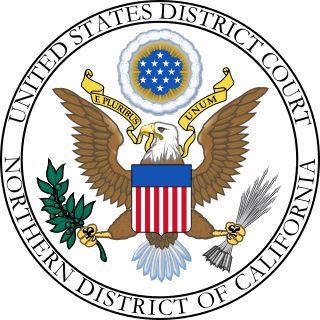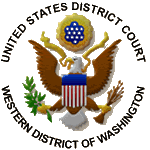
The idea–expression distinction or idea–expression dichotomy is a legal doctrine in the United States that limits the scope of copyright protection by differentiating an idea from the expression or manifestation of that idea.
The first-sale doctrine is a legal concept that limits the rights of an intellectual property owner to control resale of products embodying its intellectual property. The doctrine enables the distribution chain of copyrighted products, library lending, giving, video rentals and secondary markets for copyrighted works. In trademark law, this same doctrine enables reselling of trademarked products after the trademark holder puts the products on the market. In the case of patented products, the doctrine allows resale of patented products without any control from the patent holder. The first sale doctrine does not apply to patented processes, which are instead governed by the patent exhaustion doctrine.
A scène à faire is a scene in a book or film which is almost obligatory for a book or film in that genre. In the U.S. it also refers to a principle in copyright law in which certain elements of a creative work are held to be not protected when they are mandated by or customary to the genre.

In re Aimster Copyright Litigation, 334 F.3d 643, was a case in which the United States Court of Appeals for the Seventh Circuit addressed copyright infringement claims brought against Aimster, concluding that a preliminary injunction against the file-sharing service was appropriate because the copyright owners were likely to prevail on their claims of contributory infringement, and that the services could have non-infringing users was insufficient reason to reverse the district court's decision. The appellate court also noted that the defendant could have limited the quantity of the infringements if it had eliminated an encryption system feature, and if it had monitored the use of its systems. This made it so that the defense did not fall within the safe harbor of 17 U.S.C. § 512(i). and could not be used as an excuse to not know about the infringement. In addition, the court decided that the harm done to the plaintiff was irreparable and outweighed any harm to the defendant created by the injunction.
The exhaustion doctrine, also referred to as the first sale doctrine, is a U.S. common law patent doctrine that limits the extent to which patent holders can control an individual article of a patented product after a so-called authorized sale. Under the doctrine, once an authorized sale of a patented article occurs, the patent holder's exclusive rights to control the use and sale of that article are said to be "exhausted," and the purchaser is free to use or resell that article without further restraint from patent law. However, under the repair and reconstruction doctrine, the patent owner retains the right to exclude purchasers of the articles from making the patented invention anew, unless it is specifically authorized by the patentee to do so.

Jacobsen v. Katzer was a lawsuit between Robert Jacobsen (plaintiff) and Matthew Katzer (defendant), filed March 13, 2006 in the United States District Court for the Northern District of California. The case addressed claims on copyright, patent invalidity, cybersquatting, and Digital Millennium Copyright Act issues arising from Jacobsen under an open source license developing control software for model trains.

Mallinckrodt, Inc. v. Medipart, Inc., 976 F.2d 700, is a decision of the United States Court of Appeals for the Federal Circuit, in which the court appeared to overrule or drastically limit many years of U.S. Supreme Court precedent affirming the patent exhaustion doctrine, for example in Bauer & Cie. v. O'Donnell.
Quanta Computer, Inc. v. LG Electronics, Inc., 553 U.S. 617 (2008), is a case decided by the United States Supreme Court in which the Court reaffirmed the validity of the patent exhaustion doctrine. The decision made uncertain the continuing precedential value of a line of decisions in the Federal Circuit that had sought to limit Supreme Court exhaustion doctrine decisions to their facts and to require a so-called "rule of reason" analysis of all post-sale restrictions other than tie-ins and price fixes. In the course of restating the patent exhaustion doctrine, the Court held that it is triggered by, among other things, an authorized sale of a component when the only reasonable and intended use of the component is to engage the patent and the component substantially embodies the patented invention by embodying its essential features. The Court also overturned, in passing, that the exhaustion doctrine was limited to product claims and did not apply to method claims.

Substantial similarity, in US copyright law, is the standard used to determine whether a defendant has infringed the reproduction right of a copyright. The standard arises out of the recognition that the exclusive right to make copies of a work would be meaningless if copyright infringement were limited to making only exact and complete reproductions of a work. Many courts also use "substantial similarity" in place of "probative" or "striking similarity" to describe the level of similarity necessary to prove that copying has occurred. A number of tests have been devised by courts to determine substantial similarity. They may rely on expert or lay observation or both and may subjectively judge the feel of a work or critically analyze its elements.

Vernor v. Autodesk, Inc. was a case in the United States District Court for the Western District of Washington regarding the applicability of the first-sale doctrine to software sold under the terms of so-called "shrinkwrap licensing." The court held that when the transfer of software to the purchaser materially resembled a sale it was, in fact, a "sale with restrictions on use" giving rise to a right to resell the copy under the first-sale doctrine. As such, Autodesk could not pursue an action for copyright infringement against Vernor, who sought to resell used versions of its software on eBay. The decision was appealed to the United States Court of Appeals for the Ninth Circuit, which issued a decision on September 10, 2010, reversing the first-sale doctrine ruling and remanding for further proceedings on the misuse of copyright claim. The Ninth Circuit's decision asserted that its ruling was compelled by Ninth Circuit precedent, but observed that the policy considerations involved in the case might affect motion pictures and libraries as well as sales of used software.

Lasercomb America, Inc. v. Reynolds, 911 F.2d 970 is an appeal filed in the United States Court of Appeals for the Fourth Circuit. Initially, Lasercomb filed an action against Holiday Steel for breach of contract, copyright infringement, misappropriation of trade secrets, fraud, unfair competition, and false designation of origin. The United States District Court ruled in favor of Lasercomb, awarding them punitive damages and actual damages for fraud, rejecting the defense of copyright misuse. On appeal, based on a recognition of the similarity to patent misuse, the holding was reversed, deeming the language contained in the license agreement unreasonable.
Inwood Laboratories Inc. v. Ives Laboratories, Inc., 456 U.S. 844 (1982), is a United States Supreme Court case, in which the Court confirmed the application of and set out a test for contributory trademark liability under § 32 of the Lanham Act.

Trademark infringement is a violation of the exclusive rights attached to a trademark without the authorization of the trademark owner or any licensees. Infringement may occur when one party, the "infringer", uses a trademark which is identical or confusingly similar to a trademark owned by another party, especially in relation to products or services which are identical or similar to the products or services which the registration covers. An owner of a trademark may commence civil legal proceedings against a party which infringes its registered trademark. In the United States, the Trademark Counterfeiting Act of 1984 criminalized the intentional trade in counterfeit goods and services.

Barclays Capital Inc. v. Theflyonthewall.com, Inc., 650 F.3d 876, was a case decided in the United States Court of Appeals for the Second Circuit where the Second Circuit, reversing the decision of the US District Court below it, found that the claims of three major financial investment firms against an internet subscription stock news service (theflyonthewall.com) for "Hot-news" Misappropriation under state common law doctrine could not stand, as they were pre-empted by several sections of the Federal Copyright Act.
Morton Salt Co. v. G.S. Suppiger Co., 314 U.S. 488 (1942), is a patent misuse decision of the United States Supreme Court. It was the first case in which the Court expressly labeled as "misuse" the Motion Picture Patent/Carbice tie-in defense to a charge of patent infringement and created the present blanket remedy in infringement cases of unenforceability of the misused patent. The decision re-emphasized that misuse can be found without finding an antitrust violation.
Walker Process Equipment, Inc. v. Food Machinery & Chemical Corp., 382 U.S. 172 (1965), was a 1965 decision of the United States Supreme Court that held, for the first time, that enforcement of a fraudulently procured patent violated the antitrust laws and provided a basis for a claim of treble damages if it caused a substantial anticompetitive effect.
Princo Corp. v. ITC, 616 F.3d 1318 was a 2010 decision of the United States Court of Appeals for the Federal Circuit, that sought to narrow the defense of patent misuse to claims for patent infringement. Princo held that a party asserting the defense of patent misuse, absent a case of so-called per se misuse, must prove both "leveraging" of the patent being enforced against it and a substantial anticompetitive effect outside the legitimate scope of that patent right. In so ruling, the court emphasized that the misuse alleged must involve the patent in suit, not another patent.

National Lockwasher Co. v. George K. Garrett Co., 137 F.2d 255, is one of the earliest or the earliest federal court decision to hold that it is patent misuse for a patentee to require licensees not to use a competitive technology. Such provisions are known as "tie-outs."
Contributory copyright infringement is a way of imposing secondary liability for infringement of a copyright. It is a means by which a person may be held liable for copyright infringement even though he or she did not directly engage in the infringing activity. It is one of the two forms of secondary liability apart from vicarious liability. Contributory infringement is understood to be a form of infringement in which a person is not directly violating a copyright but induces or authorizes another person to directly infringe the copyright.
Copyright protection is available to the creators of a range of works including literary, musical, dramatic and artistic works. Recognition of fictional characters as works eligible for copyright protection has come about with the understanding that characters can be separated from the original works they were embodied in and acquire a new life by featuring in subsequent works.








